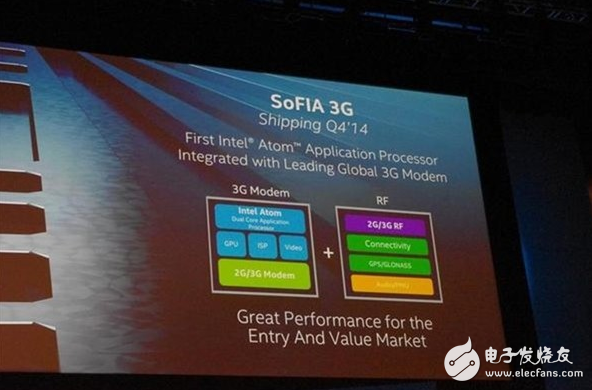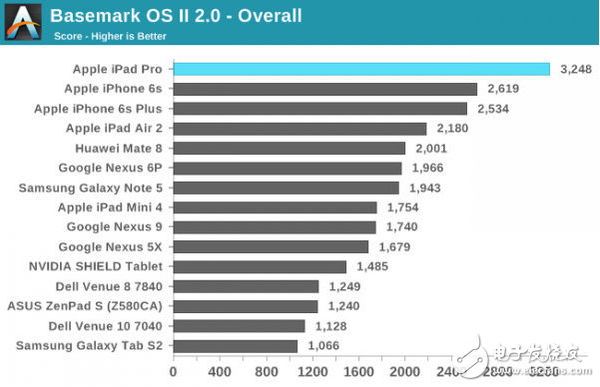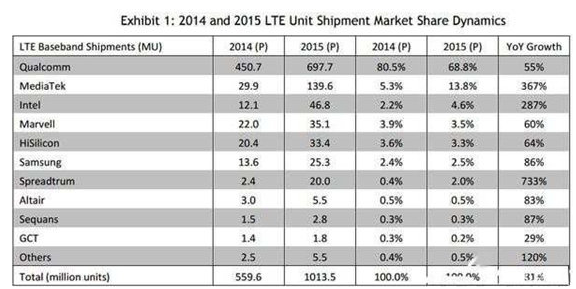Recently, as Intel stopped developing the Atom series of processor products, which are code-named Broxton (mainly for high-end) and SoFIA (mainly for low-end), mainly for smartphones, many analysts and commentators believe that This marks that Intel has abandoned the competition for the smartphone and tablet chip market. Strictly speaking, this conclusion is not accurate, because Intel CEO Brian Krzanich deliberately emphasized the market potential of baseband chips (modem chips), and the rumored Apple may have some new iPhone7 this year (expected adoption) The ratio of around 30%) Intel's baseband chip seems to have also testified Intel's efforts.

As a smart phone, the industry knows that to some extent, the mobile chip considers the integration capability of SoC (system on a chip). Among them, the role and strength of the baseband chip is more than that of the application processor. Therefore, we believe that Intel is not withdrawing from the mobile chip market, but only put more resources and energy on the baseband chip. Despite this, as the original entry into the mobile market, the original intention and the goal is mainly in the application processor (that is, the industry's fancy and evaluation of Intel's success or failure in the mobile chip market) Intel is still difficult to hide the decline of mobile decline, why?
When talking about Intel's decline in mobile, the industry always believes that it is closely related to its late entry into the mobile market. There is some truth, but it is not entirely true, because as early as 2011, Intel has announced that it will enter the mobile market with the Atom series of processors. At that time, the smartphone market was in an explosive period, and the chip market was far less intense than it is now (except for Qualcomm and MediaTek, Huawei, Apple, and Samsung’s self-developed mobile phone chips are far from showing such advantages). That is to say, it is not too late for Intel to enter the mobile phone chip market. Then the question is coming. Why is Intel not able to grasp the opportunity?
As we all know, Intel's first entry into the mobile chip market or the advantage compared with ARM-based mobile chips is performance. But the actual situation is far from that simple. That is, although in some standard running software, Atom series chips are indeed more powerful than those of the same ARM architecture, in the actual application of Android mobile phones, Atom is the leading performance in standard running software due to compatibility and other reasons. The performance of the series processors has been greatly reduced. In addition, the demand for performance of smartphone applications at that time is not as urgent as it is now. This makes the performance advantages of Intel Atom chips greatly reduced, but at the same time magnifies the weakness of excessive power consumption. It can be seen that Intel overestimated the performance of its Atom series chips and miscalculated the core requirements of the mobile market for the chip.
More deadly, in the subsequent development of mobile chips, Intel deliberately slowed down the application of Atom series chip innovation technology. The most typical performance is that in the chip process, the adoption of process technology always lags behind that of its traditional PC chip. The well-known fact is that in the chip industry, the improvement of process technology is crucial for both the performance improvement of the chip and the reduction of power consumption. At the same time that Intel deliberately slows down the adoption of innovative technologies, the innovation of chips based on ARM architecture is constantly strengthening, and ultimately it is reflected in the performance.

For example, related tests show that the single-core score of the Apple iPhone 6s A9 chip is much higher than the 1.1 Ghz version of the MacBook (with the dual-core four-threaded Core M-5Y31 processor), and the multi-core score is similar to the latter. The single-core performance of the A9 processor is also better than the 1.2GHz version of the Mackbook. As for the A9X chip used on the more powerful Apple iPad Pro, it has been tested that the Intel Core M chip with more than 12-inch MacBook configuration is far behind the Core i5 and i7 chips in the high-end Macbook Pro configuration, but A9X The computing power is not lost to the Core i5 with a low-profile Macbook Air configuration. You should know that whether it is Intel's Core M or Core i series chips, their performance is above Atom. It can be seen that Atom is in the position of mobile chips (mainly smartphones and tablets). Saved) and is reflected in the actual market. That is, many Intel mobile chip partners have abandoned the Intel Atom series chips. For example, Lenovo quickly turned to ARM-based chips after its original K-series flagship model adopted Intel Atom series chips, and ASUS, which has been insisting on adopting Intel mobile chips, recently decided to significantly reduce the use of Intel chips in its own smartphone Zenfone series. The ratio, which is said to be reduced, is only 20%.
If the above is Intel's technology mistakes in the development process of Intel's mobile chips, then the big subsidy to attack the tablet chip market in 2014 is a mistake in market strategy.
It is said that Intel's subsidies at that time were very rich, involving the marketing of tablet manufacturers, and the sales price of chips was also very low. Even in the case of slow sales of Atom chips, manufacturers could obtain subsidies for reducing losses from Intel. The US Bear Stearns Research report has estimated that Intel's subsidy on each Atom tablet is as high as 51 US dollars (more than 300 yuan), and given the global Android Tablet price is falling, most of the price Below $200, Intel’s subsidy is equivalent to a quarter of the price of Android tablets, which makes Intel’s Atom tablet chips sell at zero gross margins throughout 2014, and there are no computing chips. Refund.
It is this kind of market strategy that led to the loss of Intel’s mobile chips in 2014 alone to reach about 4 billion US dollars, plus a loss of 3 billion US dollars in 2013, its total loss reached 7 billion US dollars, due to Intel’s mobile chip division last year. Entering the PC-based client computing department, it masked the loss of mobile chips, but it is said that from 2013 to 2015, the total loss of Intel's mobile chip business has reached more than 10 billion US dollars.
As the saying goes: Money is spent on the blade. Despite a three-year loss of more than $10 billion (an average of $3.3 billion a year), Intel’s annual revenue of $55.4 billion (based on 2015 revenue) is not hurt. What’s important is that Intel’s market strategy itself exists. Paradox. Since subsidies are mostly small and medium-sized tablet manufacturers, this subsidy will not give Intel a brand effect in the mobile market, and because these middle and lower brands are on the verge of survival and bankruptcy, once Intel reduces or cancels subsidies, these brands For survival reasons, it will not hesitate to invest in the lower cost ARM chip camp, and let Intel's subsidy investment and acquired market go to the forefront, which is confirmed by the actual market afterwards.
Intel announced a reduction last year, until the cancellation of subsidies for tablet chips, the sales of its Atom chips all the way down. By the first quarter of this year, Intel's tablet chip delivery volume plummeted 44%, and the delivery of tablet chips was 4 million. In 2014 alone, the huge subsidy was about 35% of the annual shipment of 46 million pieces (11.5 million pieces shipped quarterly). It should be noted that Intel's strategy of choosing such subsidies also reflects the mistakes of the aforementioned Atom series chip technology strategy. That is to use the market strategy to make up for the mistakes of the technical strategy, but unfortunately, the final result proves that instead of making up, it is the superposition of the two strategic mistakes, which accelerates the decline of Intel mobile chips.

As mentioned at the beginning of the article, when Intel stopped developing the Atom series of processor products, mainly for smartphones, codenamed Broxton (mainly for high-end) and SoFIA (mainly for low-end), Its last chance in the mobile chip market is the baseband chip, and whether this opportunity can become a reality depends on whether Apple's iPhone7 will use Intel's baseband chip (XMM 7360 or XMM 7480) as it is rumored because Compared with the application chip (according to market research firm Strategy AnalyTIcs, Intel’s market share of global mobile phone chips was only 1% as of the end of last year). Although Intel’s performance in baseband chips is strong, it only accounts for global baseband chips. 4.6% of the market share, far behind the ranking of the first Qualcomm 68.8% and the second MediaTek 13.8% market share. In this situation, the order to win the Apple iPhone is crucial for Intel's brand influence in the mobile chip market and its morale.
I hope that Intel will not repeat the mistakes of the Atom chip in technical and market strategy mistakes.
The 8-inch tablet will have a big impact on the 7-inch and 10-inch tablet market. Because the portability of an 8-inch tablet is stronger than that of a 10-inch tablet, and the usable area is larger than that of a 7-inch tablet. The most important thing is that the price is more moderate, which is much cheaper than a 10-inch tablet. It can be said that the 8-inch tablet computer has a good balance between portability and screen display area, and is more likely to be favored by the majority of users.
8 Inches Tablet Pc,Tablet Computer,8 Inch Android Tablets,8 Inch Tablet
Jingjiang Gisen Technology Co.,Ltd , https://www.jsgisentec.com